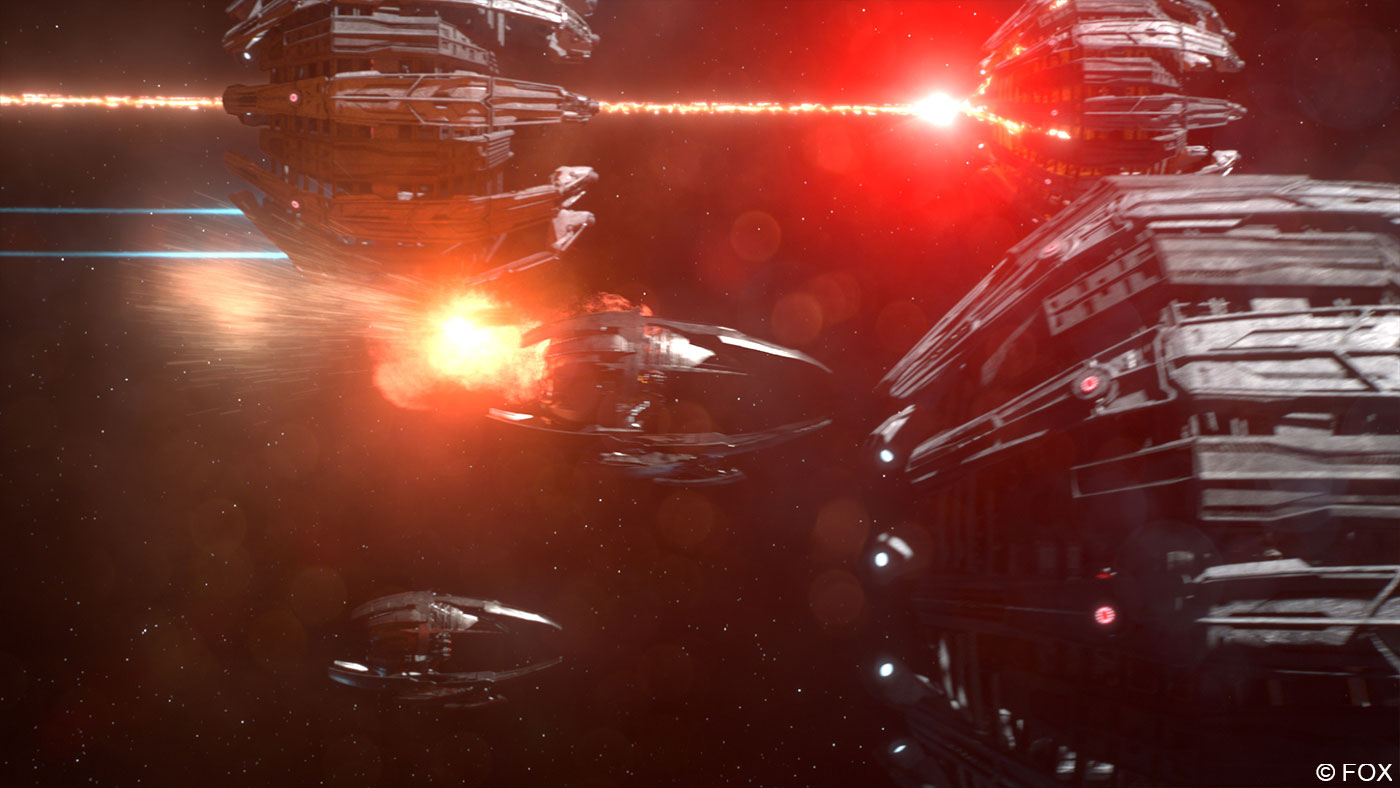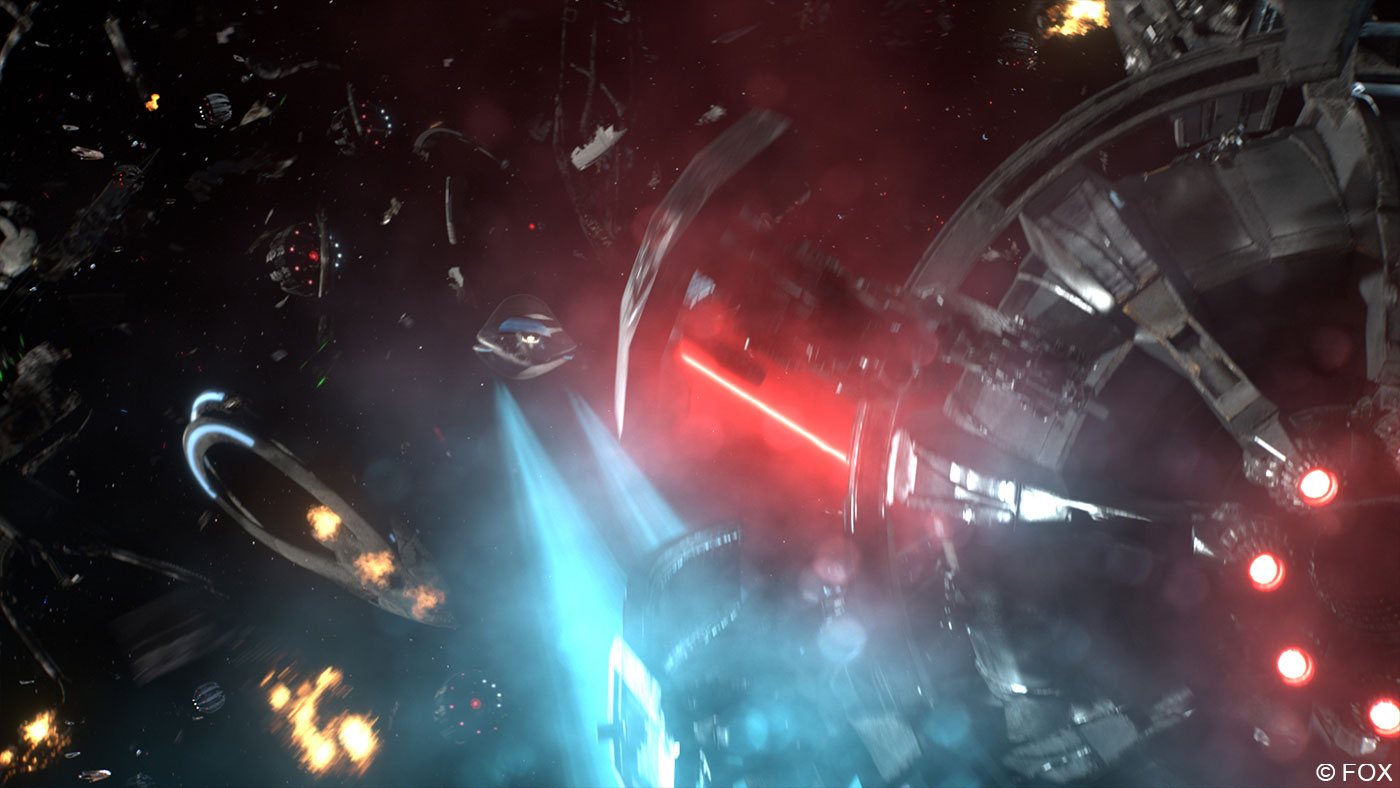The team of FuseFX, composed of Tommy Tran & Kevin Lingenfelser (VFX Supervisors) and Matt Von Brock (CG Supervisor), talk about their work on the Space Battle sequence for this episode of THE ORVILLE:
Answers from Tommy Tran and Kevin Lingenfelser:
What is your background?
Kevin: 26+ in Visual Effects. Twenty years of film and 5+ years of Television spanning 100+ projects.
Tommy: 24+ years in VFX. Twenty years in film and five years in TV.
How did you and FuseFX get involved on this show?
Kevin: Tommy and Co. were on the 1st season and our Internal VFX Producer, Brooke Noska was given the opportunity to become the VFX Producer for the entire show which resulted in more work and the ability to prove ourselves with more complex shots.
How was the collaboration with Show Creator Seth MacFarlane and VFX Supervisor Luke McDonald?
Kevin: From my perspective, it’s been pretty great and very collaborative. Seth MacFarlane knows what he wants, and we make it happen for him.
Tommy: It has been a dream. I feel that Luke and I are on the same wavelength when it comes to ideas of how things work in THE ORVILLE universe. Brooke is a rock-solid producer that is approachable when it comes to issues that may arise from time to time; I think mainly because she came from the vendor side. She knows what it’s like to be in the trenches, so she understands.
What was their expectations and approach about the visual effects?
Seth watched a lot of ROGUE ONE for the Space Battle inspiration and we attempted to emulate as much of that as we could.
How did you organize the work with your VFX Producer?
The work was split between Pixomondo and us. With FuseFX being responsible for the last two-thirds of the Space Battle.
How did you split the work amongst the FuseFX offices?
The work was all completed internally at our offices in Los Angeles.
Can you tell us more about the previs and postvis process?
Seth worked closely with Production side DFX Supervisor Brandon Fayette to meticulously plan and previs the shots for the Space Battle according to his specifications.
How did you approach this epic space battle?
Tommy: I wanted to move fast and not deliver the show at the deadline. I knew that this sequence had so many opportunities for us to add our fair to the shots. Once we accomplished filling the black holes in the sequences, it was time to “sweeten” thing up. One that comes to minds is adding a green nuclear core to one of the Krill ships as of exploded, totally uncalled for but Luke loved it.
What kind of references and indications did you receive for the space battle?
ROGUE ONE and EPISODE III provided great inspiration for the animation of the ships and explosions, debris pieces, debris fields, and laser hits.
Can you explain in detail about the creation of the various ships?
Tommy: Brandon and Seth designed the concepts and gave them to Pixomondo to complete than those assets were shared to FuseFX.
Which ship is your favorite?
Kevin: My favorite would have to be the Orville; it’s pretty unique in terms of spaceships.
Tommy: The Kaylon interceptor was my favorite.
As it’s a battle in Space, how does that affect your lighting and animation work?
Space isn’t so hard to light for as long as you can suspend your disbelief that there is no sun or light source giving light to your ship. Once you let that go. Space is your playground.
The battle has tons of FX such as lasers, explosions and more. How did you create those elements?
Tommy: We made extensive explosion libraries for explosions and space debris in advance of us getting the episode started. For lasers we had 3D firing point locators to all the ships, we then wrote a proprietary script to add lasers using the provide 3D locator and 3D cameras. This was a big time saver and may have saved us looking back now.
With so many CG assets, how did you prevent your render farm to do not burn?
Tommy: It did burn down. The AWS saved us nightly.
How did you handle the challenge of the schedule?
All said and done it was eight weeks to do the entire Space Battle.
Which sequence or shot was the most challenging?
Every shot in the Space Battle was challenging in their own right. Several close to camera shots of explosions were complicated to pull off in terms of sheer simulation and rendering to make it look realistic.
Is there something specific that gives you some really short nights?
Trying to accomplish so much in so little time can affect sleep from time to time.
What is your favorite shot or sequence?
There are so many great shots… too many to call out just one!
What is your best memory on this show?
It felt good to finish on time and to be proud of every shot and the sequence as a whole!
How long have you worked on this show?
Kevin: Just Season 2.
Tommy: Both Season 1 and 2.
What’s the VFX shots count?
Eighty-three shots in the Battle Sequence for about 7 minutes of uninterrupted run time.
What was the size of your team?
Approximately 60 CG and 2D composite artists.
What are the four movies that gave you the passion for cinema?
Kevin: STAR WARS, GODZILLA and ALIEN were life-changing events for me as a kid growing up on film.
Answer from Matt Von Brock:
How did you manage the animation of so many ships?
In many shots where we had a large volume of ships, the animation was often driven by a primary driver ship. The other ships were parented to the driver ship and had additional animation controllers to keep them from feeling locked to the driver. At any time we could pull a ship from this setup and add custom keyframed animation if needed.
Which ship is your favorite?
The Orville without a doubt. The flow of all the curves makes for a pretty ship. The Kaylon interceptors are pretty badass too.
As it’s a battle in Space, how does that affect your lighting and animation work?
Since some of the focus was towards a practical look, We often focused our lighting design on following a bit of a staged look. We enhanced assets with additional rim lights to give it a bit of the old school feel. We used cucoloris’ the cast shaped light onto the ships to provide further depth to the scene.
The battle has tons of FX such as lasers, explosions and more. How did you create those elements?
We wrote procedural tools to allow the artists to place explosions, debris, process previs, and update assets in the battle. The 2D team wrote tools to add the laser blasts to defined 3D points for the space ships.
With so many CG assets, how did you prevent your render farm to do not burn?
Our render farm can handle a large volume of work which has a near round the clock team monitoring the renders. We additionally rely on the AWS cloud service to add capacity as needed. It’s really a great and flexible system when needed.
How did you handle the challenge of the schedule?
A lot of careful planning went into defining the teams, supervising allocations, tools development ahead of the initial turnover. Once we received the previs and plates, we were prepared to work at an accelerated pace with an incredible team of artists, producers, coordinators, editors and IT. We had a single developer for the 3D tools which was integral to the success in delivering the project on time.
How long have you worked on this show?
I started with the pilot episode helping to build New York City 400 years in the future.
A big thanks for your time.
THE ORVILLE – S02E08: SPACE BATTLE BY FUSEFX
WANT TO KNOW MORE?
FuseFX: Dedicated page about THE ORVILLE on FuseFX website.
© Vincent Frei – The Art of VFX – 2019














